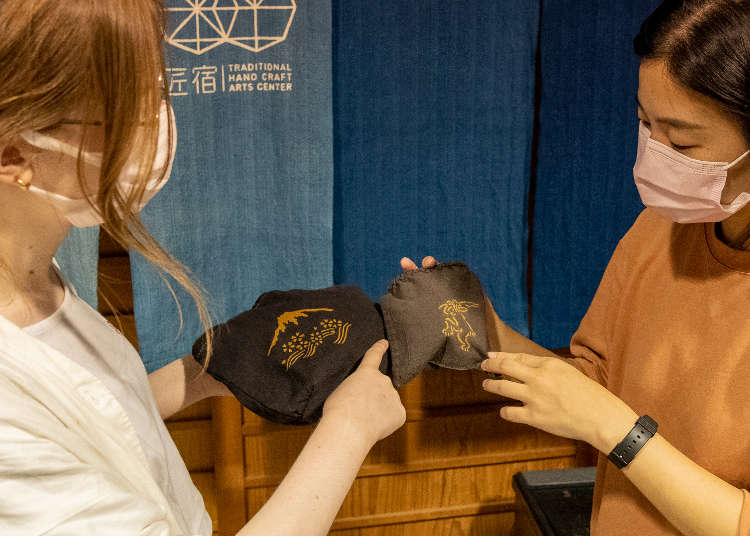
Have you ever heard of ochazome-tea dyeing? Ochazome is generally recognized as a method of plant dyeing in which tea leaves are used to color fabric. Shizuoka, otherwise known as the city of tea, has truly unique ochazome experiences to enjoy! Here you can visit sweeping tea plantations and join workshops that deepen your understanding of ochazome's connection to the tea industry.
Ochazome protects beautiful tea plantations while making use of abandoned manufacturing facilities and old tea leaves. Ochazome experiences also make you more aware of environmental conservation.
One of our writers joined forces with two members of the Live Japan editing team to learn about ochazome from a craftsman at the traditional handcrafts art center, Sumpu Takumishuku. This ochazome experience exposed our team to a new way of sightseeing in Shizuoka and became a source of inspiration!
Learning About Shizuoka Ochazome: An Experience Full of Vitality!

In Japan, tea is not only favored as a drink, but it’s also used as a dye. By experiencing ochazome tea dyeing and the many ways tea breathes life into the city, you can better understand the development of Shizuoka’s culture.
The ochazome craftsman, Mr. Kyoichiro Washizu shared, “Because Shizuoka is the producing center of tea, perfecting the technique of ochazome using local tea feels like my calling.”. As the fifth generation and owner of Washizu Dyehouse, Mr. Kyoichiro was used to making noren-traditional Japanese fabric dividers, and happi-a traditional tube-sleeved Japanese coat. In an age where fabrics can be mass produced by machines, he wanted to step out of his comfort zone and experiment.

During the interview, Mr. Washizu shared his abundant knowledge on ochazome. Ochazome is a method of plant dyeing that uses tea leaves as a colorant. Though this dyeing method isn’t mainstream, it has been long-used and recognized as a contributor to the environmental cycle.
Ochazome boils old tea leaves left over from the tea manufacturing process to create a natural dye. The boiled tea leaves can then be mixed with wood chips to make a compost. Mr. Washizu added, “Tea leaves seek nourishment from the dirt they grow from. Once the leaves have been used for ochazome, I return them back to the earth.” Over the span of ten years, Mr. Washizu has tirelessly experimented to create his own ochazome technique.

Mr. Washizu owns his own dyehouse in Shizuoka. After becoming interested in the city’s tea industry, he wanted to breathe economic value back into abandoned tea plantations and old tea leaves. Combining the traditional Shizuoka craft of Suruga Wazome-a dyeing technique known for its intricate navy and white designs, with tea has resulted in something truly amazing! This craft also meets important Sustainable Development Goals (SDGs).
Mr. Washizu shared, “If tea is only produced as a drink, the amount of unused tea leaves will increase while the number of tea plantations decreases. A rise in abandoned tea plantations may also cause a range of environmental issues. An alternative way to produce economic value for tea will help preserve Shizuoka’s vast tea plantations.”.
In addition to using tea leaves to dye fabrics, Mr. Washizu sees Shizuoka ochazome developing into a recycling opportunity. This would be realized through cultivating the city’s tea plantations, producing tea leaves, and returning used tea leaves back to the earth.
Upon listening to Mr. Washizu’s story, our editors were moved by his firm sense of mission and felt motivated to experience the charm of Shizuoka ochazome themselves.
Experiencing the Allure of Shizuoka Ochazome at Sumpu Takumishuku
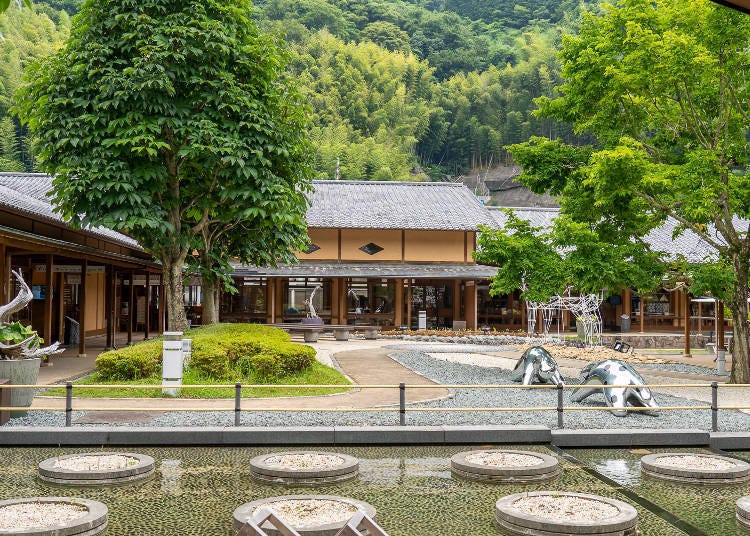
Sumpu Takumishuku is one of Japan’s largest traditional handcrafts art centers. Here you can take part in dye workshops (ochazome, indigo dyeing), Suruga bamboo ware workshops, pottery workshops, woodworking workshops, and lacquerware-making workshops. Our editing team decided to try the bamboo and dye workshop!
Sumpu Takumishuku is located an approximately 15-minute taxi ride or an approximately 30-minute bus ride from Shizuoka Station. When taking the bus, the facility is a five-minute walk from the bus stop. For more information on how to access Sumpu Takumishuku, please refer to the information listed at the end of the article.
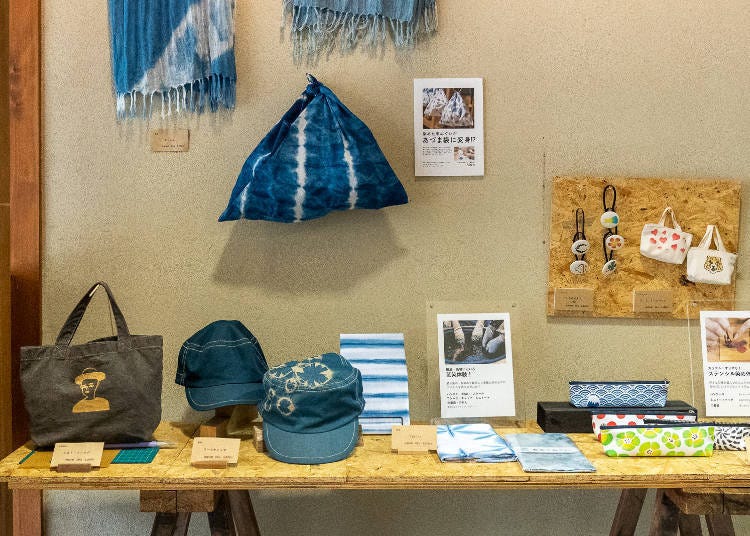
For the ochazome workshop, you can choose to dye either a tote bag or pouch. (This may change depending on the craftsman leading the workshop.) Parts of the tote bag or pouch are already dyed using the ochazome technique so that participants can focus on katazome-a method of stencil dyeing used to color specific sections of cloth.
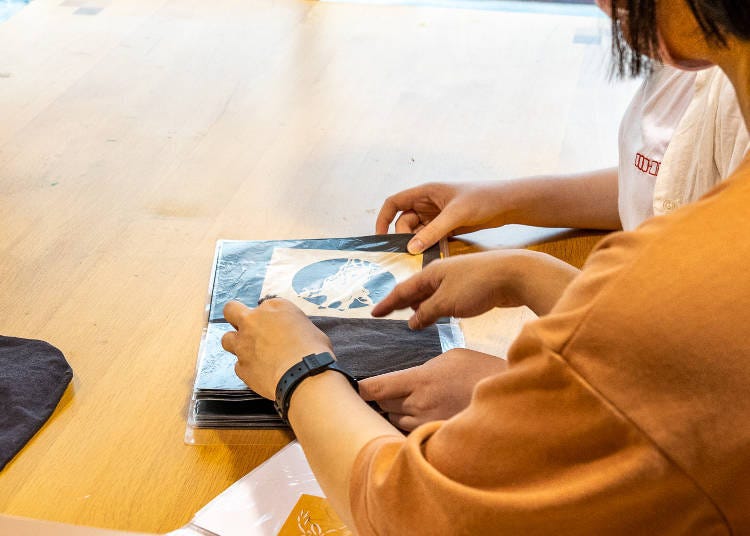
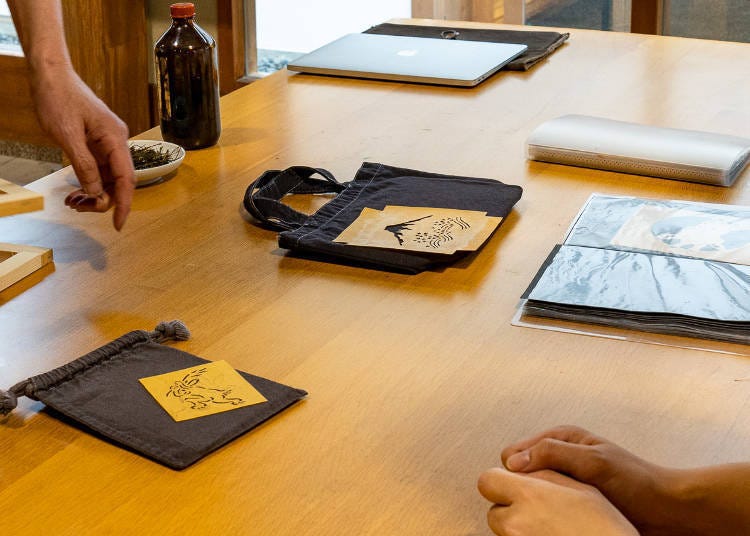
Our editor from New Zealand chose a Mt. Fuji and cherry blossom design for her tote bag. This is a popular design as Mt. Fuji and cherry blossoms are representative of Japan for both Japanese people and foreign visitors.
Our editor from Taiwan chose a Choju-Giga design. Choju-Giga refers to famous set of picture scrolls handed down from generation to generation at Kozan-ji Temple in Kyoto. The picture scrolls are said to be Japan’s oldest manga as they personify animals to satirically depict society of that time.
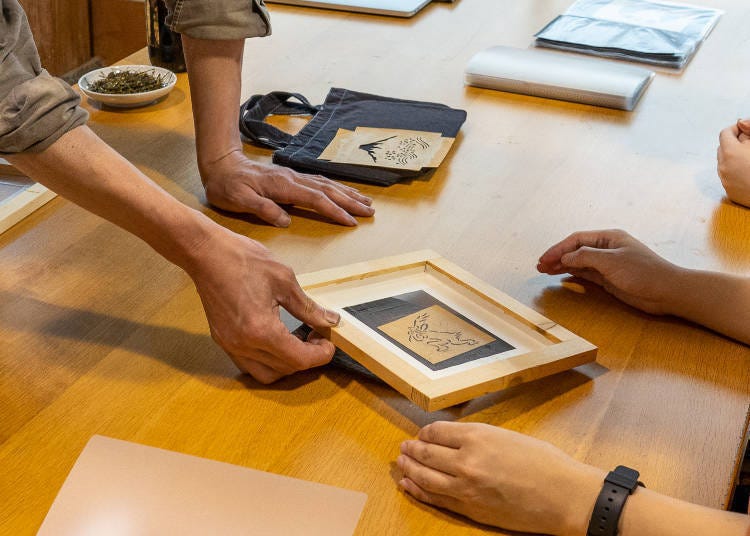
At the ochazome workshop, you’re asked to choose a frame that fits the size of your chosen design. Then, you can figure out where the design would fit best. Workshop staff will assist you in applying printing paste. Once the paste is evenly distributed along the frame, the katazome process is complete!
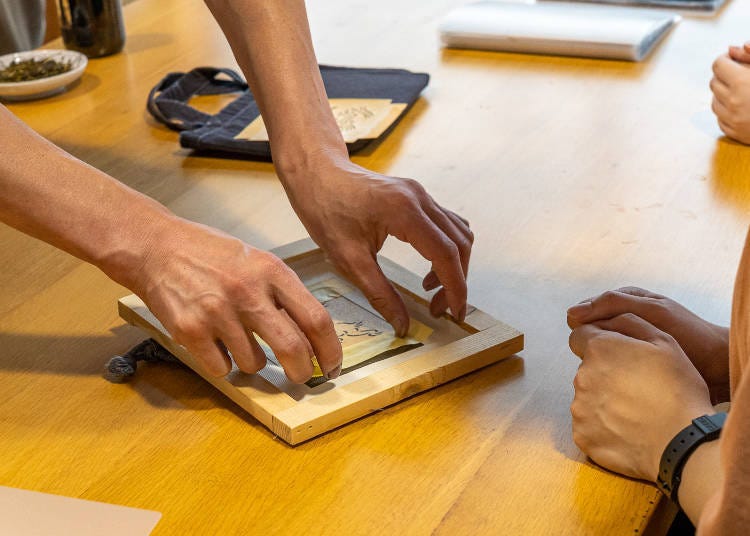
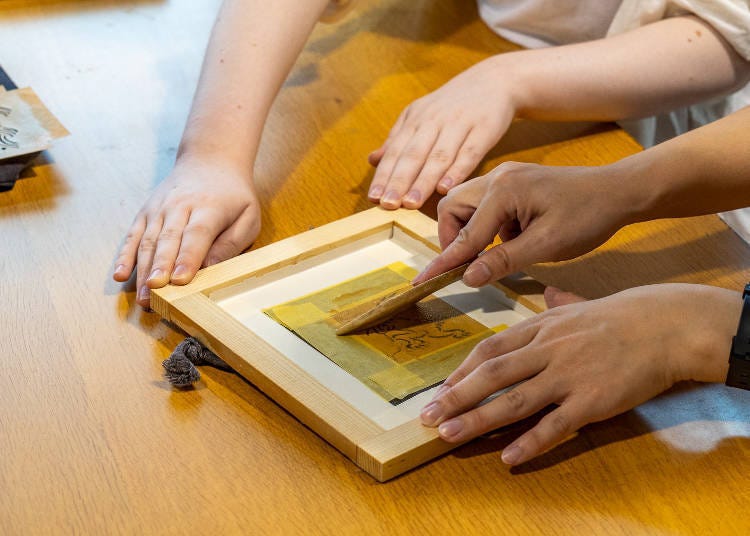
In order to avoid leaks and applying the printing paste in the wrong sections, yellow tape is placed around certain parts of the frame. During the workshop, we recommend staying focused so that the printing paste can be applied evenly.
Our editor from New Zealand commented, “Applying the printing paste on your own while making sure the frame doesn’t move is a little challenging. It’s better if you and your workshop buddy can work together.”

After applying the paste, you can remove the frame at once or little by little. We recommend choosing the easiest method that will prevent the printing paste from spreading or leaking.
The ochazome workshop ends here! It’s a speedy workshop that lasts approximately 30 minutes. Mr. Washizu added, “You don’t have to prepare anything for this ochazome workshop. On top of it being a fairly clean process, it’s hard to mess up the design. I recommend the workshop as it can be enjoyed fairly casually.”
This is a casual craft workshop where you can learn about ochazome while using old tea leaves to dye the item of your choice! The main purpose of this workshop is to offer an easy experience introducing ochazome-a unique cultural craft from Shizuoka.
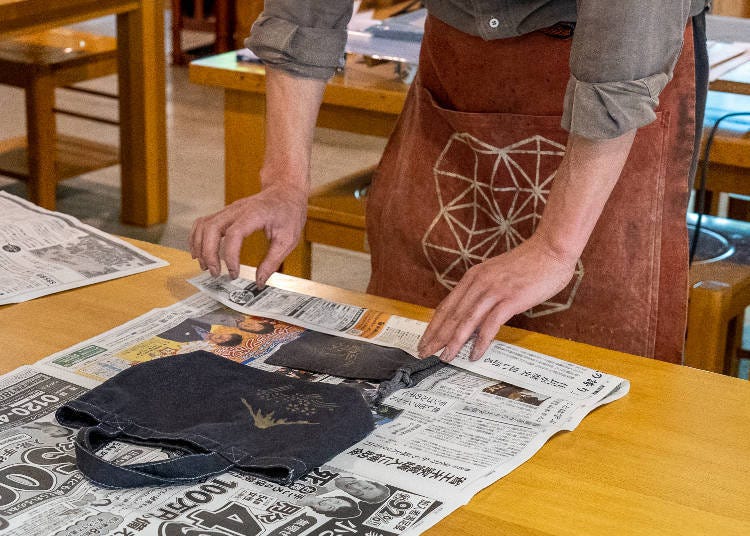
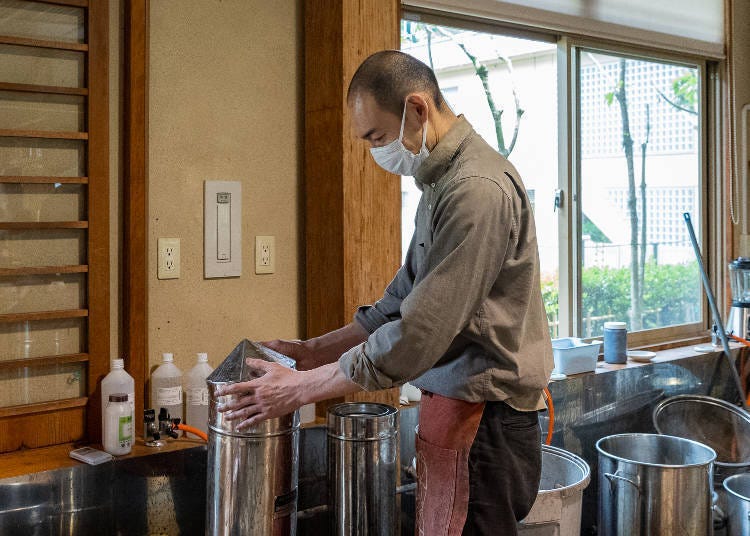

After the workshop, our editor from Taiwan commented, “The fabric you use is already dyed using the ochazome technique. It’s a super easy process because all you have to do is stencil your desired design.” Only taking 20 to 30 minutes, this workshop comes highly recommended for families or friends visiting the area.
Above all, the feeling of achievement you get after you’ve made your ochazome product is like no other! Our editor from Taiwan was overjoyed, commenting, “You can choose the color and design you want as well as where you want to place your design! My pouch is truly one of a kind!”.
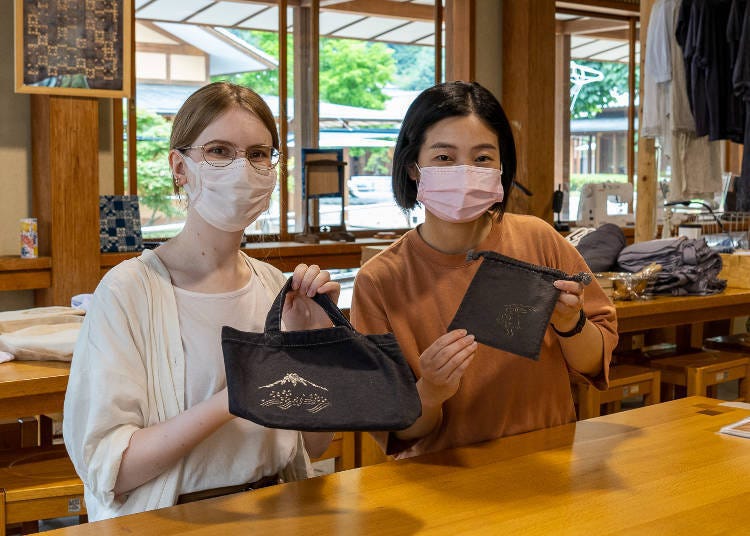
By listening closely to instructions and explanations by a craftsman, you can understand the significance of ochazome. What’s more, you can experience the ochazome process first-hand! Our editors couldn’t stop looking at their handmade ochazome items. Our editor from New Zealand shared emotionally, “I will use the bag I’ve made with care.”.
Enjoy an Easy Ochazome Experience and a Range of Fashionable Items Available for Purchase!
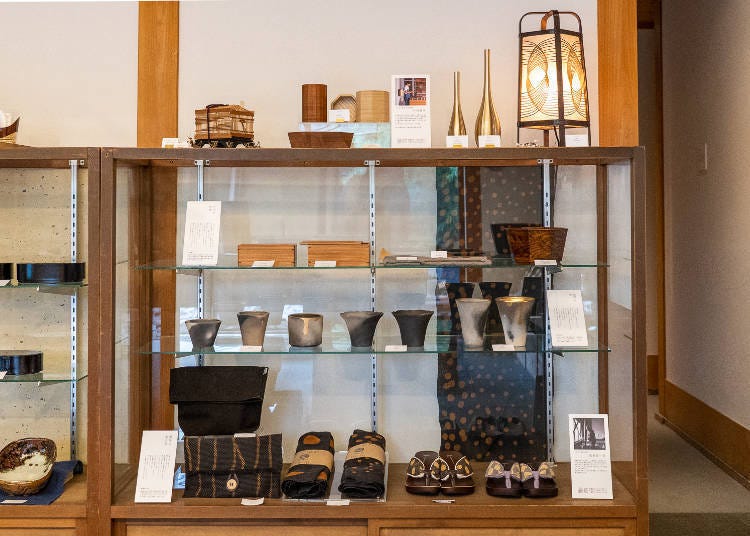
The workshop offers an interactive ochazome experience! Once you’re done, you can either take the finished product home with you or send it by a domestic courier service. At Gallery Teto Teto, ochazome works made by Mr. Washizu are displayed, and some are even available for purchase! Mr. Washizu’s works stray from conventional ochazome crafts and center around household goods as well as fashion items. Examples of what you may find include bags, place mats, scarves, and straps for geta-traditional Japanese, wooden sandals.
Moreover, you can dye your old t-shirts and jeans using the ochazome technique! At Sumpu Takumishuku, logos of noren curtain, the workshop facility’s interior, and t-shirts or jackets worn by staff are all ochazome-dyed.
About Sumpu Takumishuku
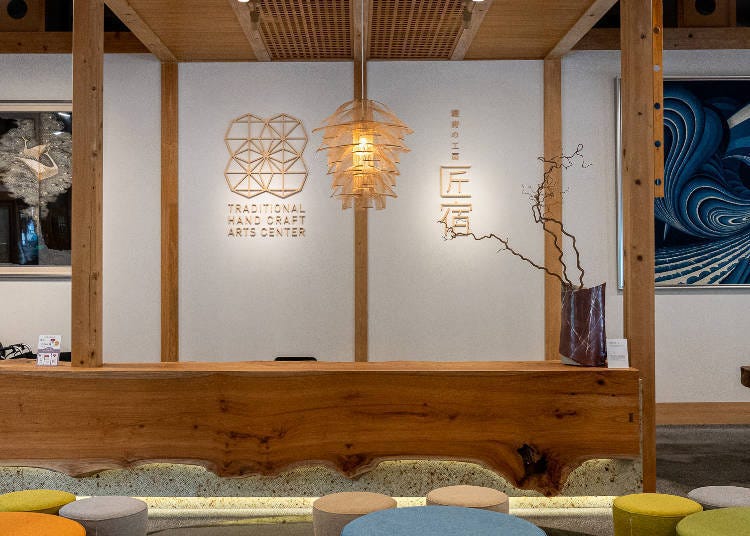
On the day of our visit, Mr. Washizu guided us through our ochazome experience. However, depending on the day, the craftsmen and staff in charge may vary. The post handling process after the workshop is quite extensive, so it won’t be possible to take your product home the day you’ve made it. If you live in Japan, finished products can be couriered (shipping fees must be paid out of pocket and the workshop items take about a week to finish.)
- 【Multilingual services】
- Only in Japanese
- 【Health & Safety Measures】
- Indoor disinfection measures taken - Sanitizer installed - Disinfected after each guest leaves - Ventilation measures in place - Coin trays used - Staff wear masks, gargle, wash hands regularly, and monitor body temperature - Limited capacity/increased space between seats - Restricted admission, reservation system in place - Entry declined to anyone who is feeling unwell - Masks requested/temperature check enforced
Experience the Vital Qualities of Shizuoka Tea through Ochazome
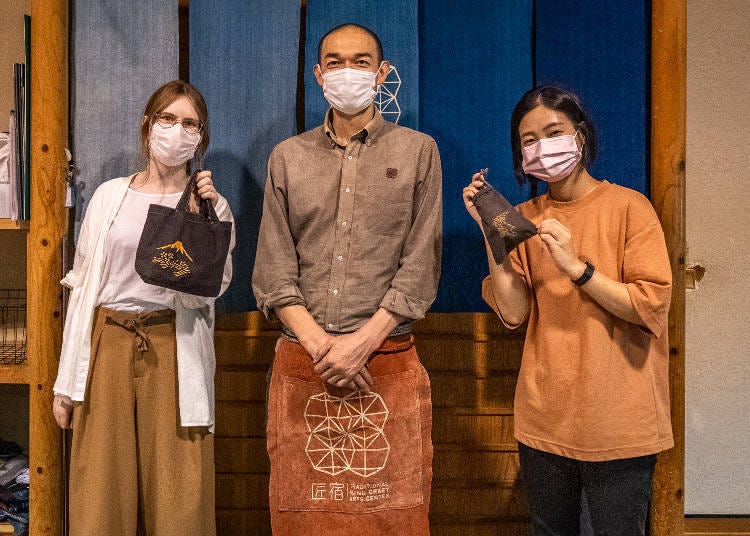
Although ochazome isn’t a mainstream dyeing technique, Mr. Washizu has skillfully and successfully combined traditional dyeing techniques with Shizuoka’s tea industry-paving a new path for further developing the industry.
Tea leaves grown in tea plantations are used for ochazome and then returned to the soil so that they can become nutrients. This process enables you to feel the cyclical vitality of tea leaves. Additionally, ochazome products such as fabric, clothing, and other keepsakes can be used daily-enabling you to realize the importance of conservation practices. The vital qualities of tea can be experienced through ochazome workshops and the products made by each participant. All of the above contributes to the infinite cycle of Shizuoka tea.
-
Sumpu Takumishuku駿府の工房 匠宿
- Address 3240-1 Mariko Suruga-ku, Shizuoka-shi, Shizuoka
-
Nearest Station
From JR Shizuoka Station’s North Exit 7, get on the Shizutetsu Justline bus bound for “Chubu-Kokudo-Sen, Fuji-e Ekimae Iki”. Get off at “Togetsu Posuputaku Mishuku Iriguchi” and walk for approximately 5 minutes to the facility.
- Phone Number 054-256-1521
Hours: 10:00 a.m. to 7:00 p.m.
Closed: Mondays
Workshop: Bamboo and Dyeing
Experience fee: tote bags are 3,000円 (including tax)/pouches are 1,200 yen (including tax), Optional: Original stencil designs are 500 yen
*Workshop content is subject to change. For updated information, please refer to the official site. (As of August 2022, pouches are unavailable to dye.)
*Ochazome workshops and dyeing techniques may vary depending on the schedules of workshop and facility staff.
Official Website: https://takumishuku.jp/
*Interviewee: Public Interest Incorporated Foundation SURUGA Marketing & Tourism Bureau
VISIT SURUGA - 日本一のお茶どころ、 SURUGAのお茶を巡る旅へ。
*The information in this article is from June 2022. For updated information, please refer to the official website.
Written by Kayo
- Area
- Category
*Prices and options mentioned are subject to change.
*Unless stated otherwise, all prices include tax.
Popular Tours & Activitiess
Recommended places for you
-
Coupons

Puppy Café Rio Shinjuku
Culture Experience
Shinjuku
-
Events

Japanese-style Healing Salon WANOKUNI
Culture Experience
Akihabara
-
Events

Asakusa Kimono Rental『DAIKICHI』
Culture Experience
Asakusa
-

Art Café T8 ASAKUSA
Culture Experience
Asakusa
-
Coupons

WASAKE Sake Experience
Culture Experience
Asakusa
-

FUJI JAPAN Asakusa
Culture Experience
Asakusa
-

The Best Japanese Food Representing 2025! 'Dish of the Year®' Annual Award Results Announced
-

Tokyo City Pass Upgrade: Harry Potter Studio Tour & Top Sights up to 85% Off
by: Guest Contributor
-

How to Get Don Quijote's Exclusive 2025-2026 Winter Gift (+Tax-Free Savings)
-

A Travel Game Changer! Go Hands-Free Between Tokyo and Kyoto with LUGGAGE EXPRESS by JTB and JR Tokai
by: Guest Contributor
-

New Seibu L00 Series Launching in 2026! What to See Along the Tokyo-Area Golden Route
by: Guest Contributor
-
Ad

Preserving the Beauty of World Heritage Site Shirakawa-go for the Future Through Responsible Travel
Inspiration for Accommodations
-

Enjoy Mt. Fuji from the Comfort of Your Room! Recommended Ryokan with Mt. Fuji View
-

Stay Near the Cherry Blossoms! Hotels for Cherry Blossom Viewing in Tokyo
-

Family-Friendly Hotels with Free Shuttle to Disneyland: Convenient Access for a Magical Stay
-

Top Ranked Hakone Hotels with Mt. Fuji View: Enjoy Stunning Scenery from Your Private Space
-

Convenient Tokyo Hotels with Airport Shuttle: Ideal for Families and Heavy Luggage
-

Stunning Tokyo Tower View Hotels: Enjoy Spectacular Scenery from Your Private Space
-

Convenient Asakusa Hotels with Kitchens: Ideal for Extended Family Visits
-

Experience Luxury: Hakone's 10 Best Five-Star Accommodations
-

Enjoy Mt. Fuji Autumn Leaves! Top Hotels Near the Popular Autumn Leaves Corridor
-

Experience Hakone Fall Foliage from Your Room with Stunning Views
-

6 Surprisingly Cheap Things in Japan
-

Samurai Swordsmanship: Taking a Real Battōjutsu Class in Tokyo! (Video)
-

Four Free Spots in Tokyo to Rejuvenate your Mind and Body
-

Top 5 Tokyo Cultural Activities Even Local Residents Have on Their Bucket Lists!
-

Enjoy Japanese Culture When Traveling to Tokyo With These Specially Curated Experiences
by: James Davies
-

Secrets to Shopping in Japan: Guide to Annual Sales in Japan & Where to Shop
by: Miyu Shimada
- #best ramen tokyo
- #what to buy in ameyoko
- #what to bring to japan
- #new years in tokyo
- #best izakaya shinjuku
- #things to do tokyo
- #japanese nail trends
- #what to do in odaiba
- #onsen tattoo friendly tokyo
- #daiso
- #best sushi ginza
- #japanese convenience store snacks
- #best yakiniku shibuya
- #japanese fashion culture
- #best japanese soft drinks












